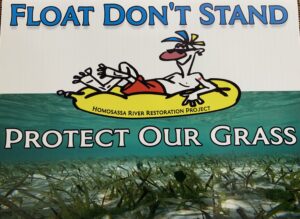JULY 2023 HOMOSASSA RIVER RESTORATION OVERVIEW.
Restoration efforts on the Homosassa River began in the fall of 2020. Phase 1, approximately 25 acres, has been dredged of Lyngbya and detrital material and thousands of eelgrass plants installed. Maintenance of Phase 1 is ongoing. Phases 2 and 3 which will complete the restoration of the “Bluewaters” (headwaters to the confluence of the Halls River) section is currently on hold awaiting permits. Due to the efforts of Senator Blaise Ingoglia and Representative Ralph Massullo funding is in place to complete all of Phase 2 and begin Phase 3.
PERMITTING:
It has been 2 years and 4 months since Homosassa River Restoration Project Inc. applied for the Army Corps permit for Phases 2 and 3. After numerous phone calls, emails, and even after some much appreciated assistance from Congressman Gus Bilirakis, we are still waiting. HRRP has had the necessary Department of Environmental permit for approximately 18 months but must have both the DEP and Army Corps permits to move forward. There is hope that the permit will be granted by mid August giving the contractor, Sea & Shoreline, only 2 months of working time left before the project must be shut down for the winter manatee season.
A restoration project of this type is always a two steps forward and 1 step back approach. The algae does not want to give up its dominance and allow the grass to grow and flourish. Without the proper permits and unable to continue the restoration project downstream from Phase 1 our progress has slowed and allowed the algae to outcompete the grass.
Speaking of Algae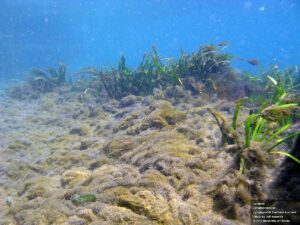
Besides Lyngbya algae there is also an algae called Chaetomorpha. It is an algae that has been documented in the Homosassa River since the early 90’s and can cover up to 80% of the river in many areas. One reason the algae is out of control is that Homosassa River does not have a primary producer, i.e. eelgrass. Primary producers are the basis of the food chain and are critical to the health of the ecosystem. Currently, algae uptakes nutrients and grows out of control because it has no competition. With the establishment of a primary producer, in our case eelgrass, HRRP will begin to combat the algae naturally. Eelgrass beds absorb excess nutrients, increase oxygen levels and stabilize the river bottom. All leading to a healthier system and fewer algae blooms.
Until we can tip the balance from an algae dominated system to a plant dominated system HRRP and Sea & Shoreline will continue working together to address the algae blooms through mechanical maintenance. The barge currently on the river has a crew of experienced divers vacuuming the algae out of the river by hand, targeting the areas that have dense algae accumulation. This process will allow young eelgrass plants to regain access to sunlight so they can continue to grow and establish in these areas.
So what about the Grass?
Growth and establishment of Submerged Aquatic Vegetation (SAV) takes time. Much like the perennials in your yard and garden, they follow a similar pattern; SLEEP, CREEP, them LEAP!
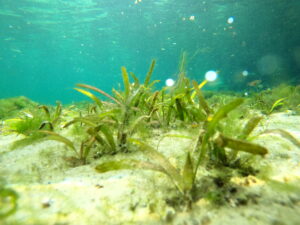
When SAV is first planted it may not look like it is doing much from the surface but there is a lot going on underground. Many plants spend the first year or two utilizing their energy on generating a healthy root system. That is the basis for strong and healthy plants.
The grass then begins to CREEP.
Once a healthy root system is established they begin to create new plants.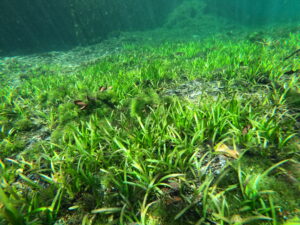 Again, it may not look like much from the surface, but if you take a closer look, you will see many new young plants breaking through along the river bottom. Eelgrass has rhizomes which enable them to create new plants right from the original parent plant. These new plants then extend their own rhizomes and the process continues.
Again, it may not look like much from the surface, but if you take a closer look, you will see many new young plants breaking through along the river bottom. Eelgrass has rhizomes which enable them to create new plants right from the original parent plant. These new plants then extend their own rhizomes and the process continues.
Finally they LEAP.
When the plants have established strong healthy root systems and denser coverage we will begin to see a noticeable difference. Fighting back against the algae that now controls the waterway. Long blades and flowers reaching to the surface of the water. Beds of grass waving in the currents.
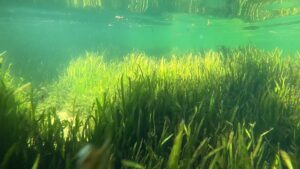
What’s Next?
Well that depends. If Army Corps releases the permit in the next week or two Sea & Shoreline divers will begin restoration in Phase 2 within a few days and will work right up until our winter deadline which is November 15, 2023. At this time no winter work is allowed. HRRP must also secure the funding necessary to complete Phase 3. Maintenance of all areas will continue into 2024 as well.
What Can You Do To Help
- Continue to spread the message of “Float Don’t Stand”.
- Do not anchor in eelgrass beds or on top of exclusion cages.
- Practice responsible anchoring. Do not drag your anchor or better yet use a pole anchor.
- Raise your prop when in shallow water.
- Like us on Facebook and follow our progress.
- Donate. Help us continue moving the restoration project downriver.
